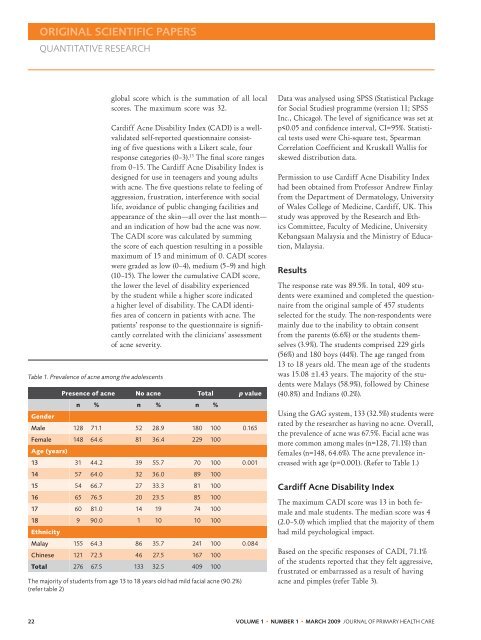entire issue. - The Royal New Zealand College of General ...
entire issue. - The Royal New Zealand College of General ...
entire issue. - The Royal New Zealand College of General ...
Create successful ePaper yourself
Turn your PDF publications into a flip-book with our unique Google optimized e-Paper software.
ORIGINAL SCIENTIFIC PAPERS<br />
qUANTITATIVE RESEARCH<br />
Table 1. Prevalence <strong>of</strong> acne among the adolescents<br />
Gender<br />
global score which is the summation <strong>of</strong> all local<br />
scores. <strong>The</strong> maximum score was 32.<br />
Cardiff Acne Disability Index (CADI) is a wellvalidated<br />
self-reported questionnaire consisting<br />
<strong>of</strong> five questions with a Likert scale, four<br />
response categories (0–3). 13 <strong>The</strong> final score ranges<br />
from 0–15. <strong>The</strong> Cardiff Acne Disability Index is<br />
designed for use in teenagers and young adults<br />
with acne. <strong>The</strong> five questions relate to feeling <strong>of</strong><br />
aggression, frustration, interference with social<br />
life, avoidance <strong>of</strong> public changing facilities and<br />
appearance <strong>of</strong> the skin—all over the last month—<br />
and an indication <strong>of</strong> how bad the acne was now.<br />
<strong>The</strong> CADI score was calculated by summing<br />
the score <strong>of</strong> each question resulting in a possible<br />
maximum <strong>of</strong> 15 and minimum <strong>of</strong> 0. CADI scores<br />
were graded as low (0–4), medium (5–9) and high<br />
(10–15). <strong>The</strong> lower the cumulative CADI score,<br />
the lower the level <strong>of</strong> disability experienced<br />
by the student while a higher score indicated<br />
a higher level <strong>of</strong> disability. <strong>The</strong> CADI identifies<br />
area <strong>of</strong> concern in patients with acne. <strong>The</strong><br />
patients’ response to the questionnaire is significantly<br />
correlated with the clinicians’ assessment<br />
<strong>of</strong> acne severity.<br />
Presence <strong>of</strong> acne No acne Total p value<br />
n % n % n %<br />
Male 128 71.1 52 28.9 180 100 0.165<br />
Female 148 64.6 81 36.4 229 100<br />
Age (years)<br />
13 31 44.2 39 55.7 70 100 0.001<br />
14 57 64.0 32 36.0 89 100<br />
15 54 66.7 27 33.3 81 100<br />
16 65 76.5 20 23.5 85 100<br />
17 60 81.0 14 19 74 100<br />
18 9 90.0 1 10 10 100<br />
Ethnicity<br />
Malay 155 64.3 86 35.7 241 100 0.084<br />
Chinese 121 72.5 46 27.5 167 100<br />
Total 276 67.5 133 32.5 409 100<br />
<strong>The</strong> majority <strong>of</strong> students from age 13 to 18 years old had mild facial acne (90.2%)<br />
(refer table 2)<br />
Data was analysed using SPSS (Statistical Package<br />
for Social Studies) programme (version 11; SPSS<br />
Inc., Chicago). <strong>The</strong> level <strong>of</strong> significance was set at<br />
p

















